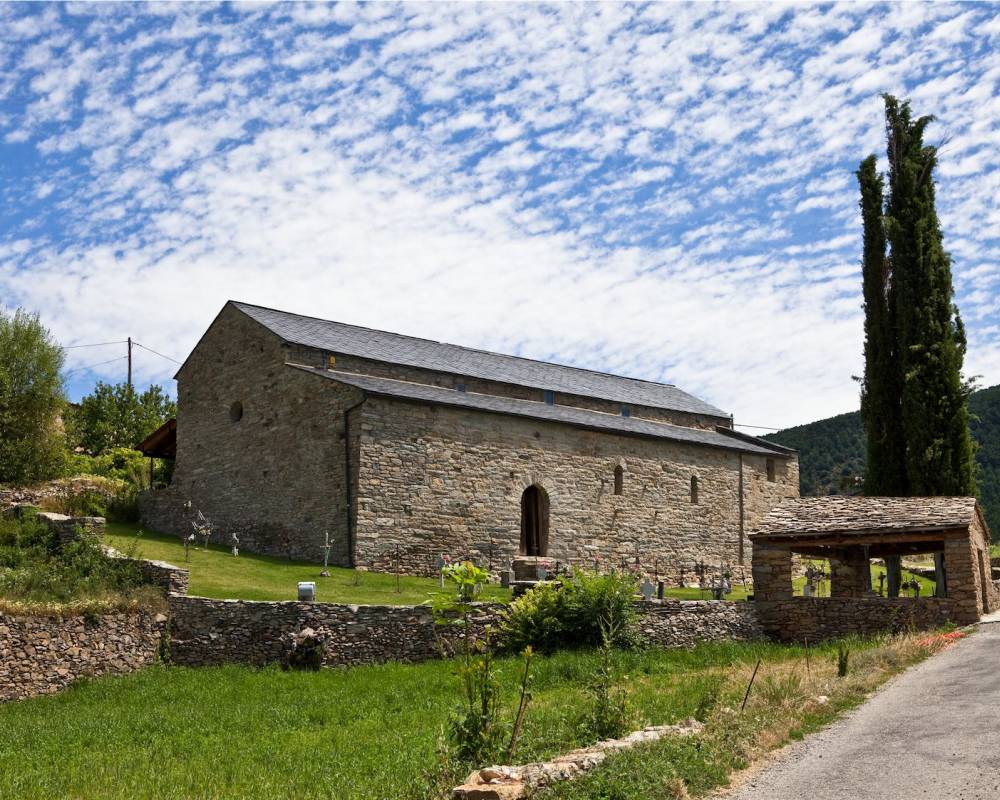
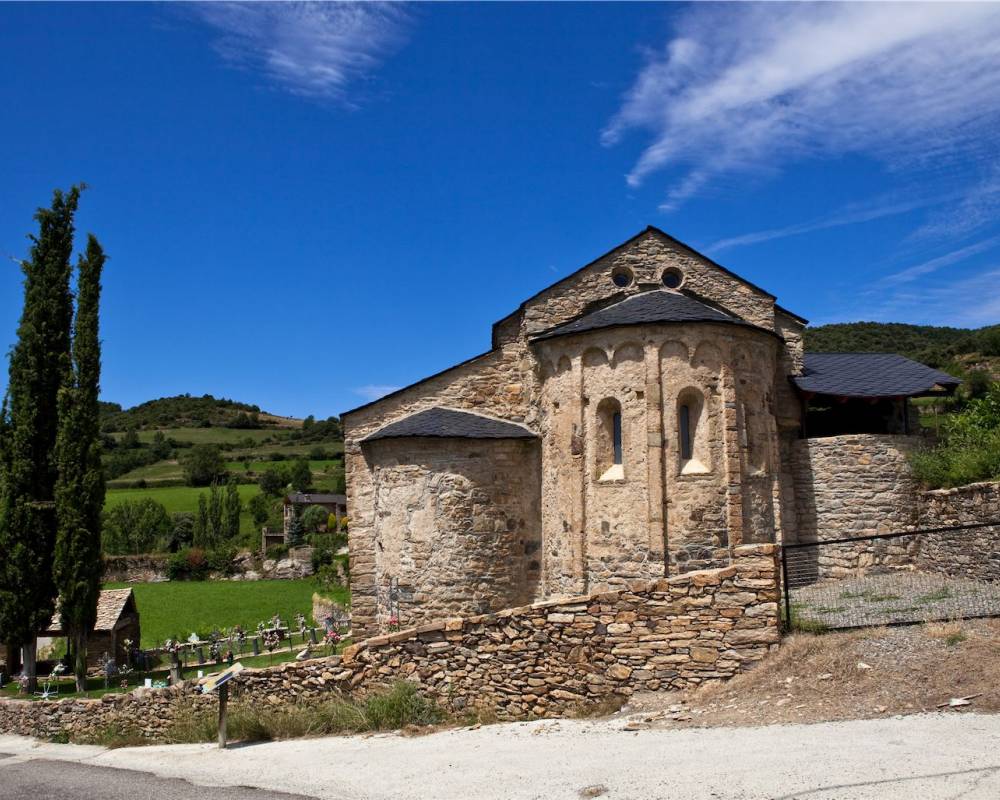
Until the late nineties, entering the church of Sant Vicenç d’Estamariu was a risky affair. As you leave Cerdanya behind, out of nowhere a magnificent Lombard lobed apse appears, giving the first sign of a church situated at the entrance to the town of Estamariu, with a powerful medieval past.
Like ruins swallowed up by the forest, Sant Vicenç rose up towards heaven to found what had been: one of the most important strategic locations in the battle for Castellbò during the Early Middle Ages.
It wasn't until 1993 when the first volunteer expedition, encouraged by the Centre d’Estudis de l’Alt Urgell, decided to clear the hedges of the church that was in danger of becoming a ruin.
The surprise, which those first explorers had already suspected was there, was the discovery of the magnificent Roman mural preserved in the apse of the church and the gothic decoration of the apsidiole, which make Estamariu one of the most important sites for murals preserved in situ in the whole of Catalonia.
The discovery of the frescoes of Sant Vicenç and their preservation is therefore the result of coincidence and luck, as is the case in so many other mountain churches.
Church of Sant Vicenç . Josep Giribet/ Department of Culture. CC BY – NC 2.0
The church of Sant Vicenç d’Estamariu was built around the year 1040 and is part of what are known as Lombard-style buildings. It has an individual structure based on a basilica plan with three parallel naves headed by apses, which were typically reserved for cathedrals and monasteries.
The 18th century marked the beginning of the end of the temple, when the church of Santa Cecília replaced it and Sant Vicenç, which had previously been a splendid church, became forgotten.
Inside the church. Detail of the semi-circular side arches. Josep Giribet/ Department of Culture. CC BY – NC 2.0
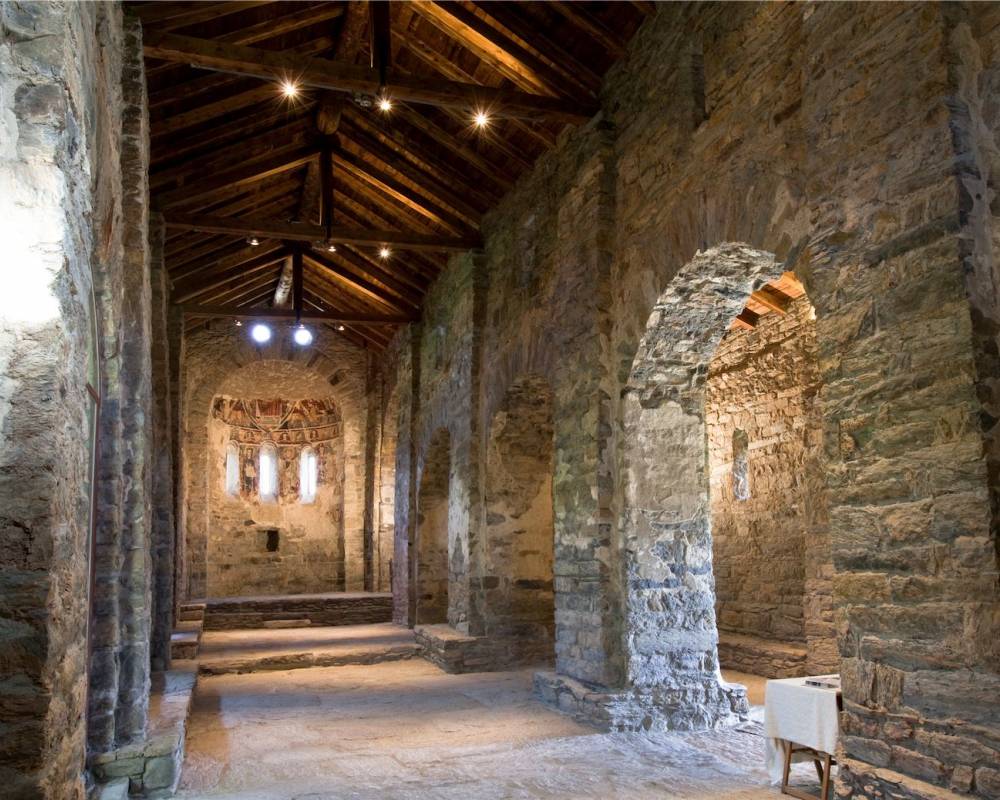
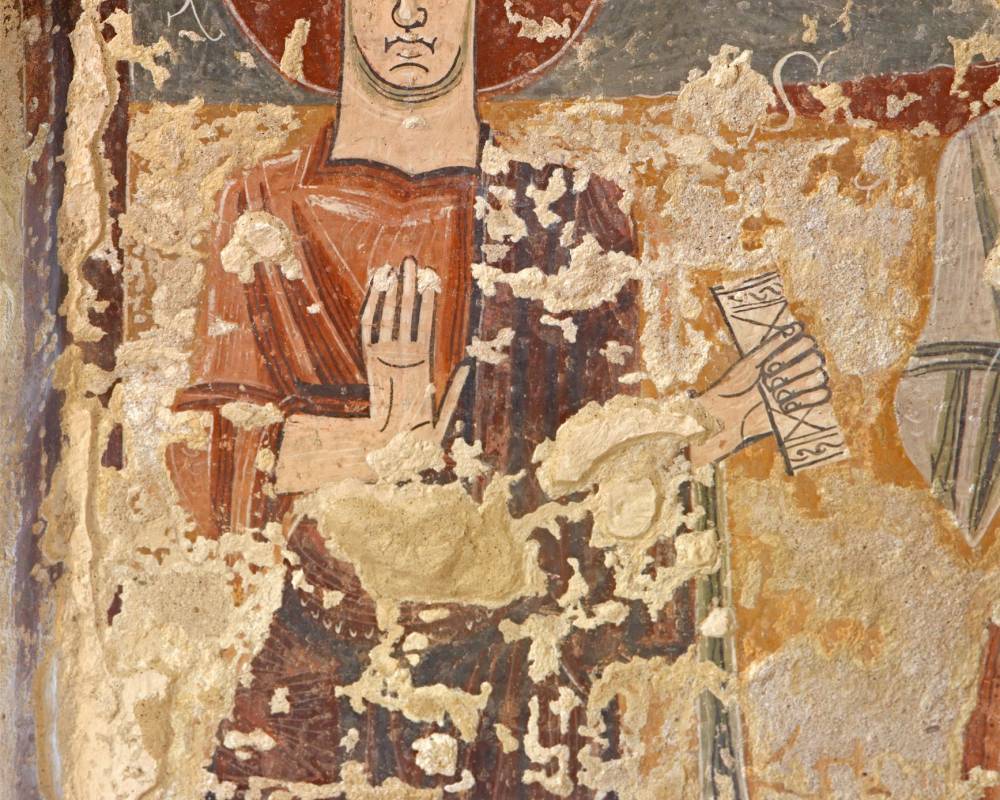
The building of a new church in the town relegated Sant Vicenç to other, less religious uses. However, that deterioration in status was a lucky break for the frescoes.
The architectural structure of the presbytery that hid them was kept intact and the fact that thy were covered by a layer of lime meant that they remained hidden from the eyes of aggressors and prospectors and even the Junta de Museus de Catalunya (Board of Museums of Catalonia) itself, as had happened in the case of the paintings of Sant Víctor de Dòrria (Ripollès), Sant Tomàs de Fluvià (Baix Empordà) and Baiasca (Pallars Sobirà).
Central apse. Detail of the Apostle Sant Joan, fresco (13th cent.). Josep Giribet/ Department of Culture. CC BY – NC 2.0
The experts who have worked in Estamariu speak about paintings with an exceptional iconographic programme and style. In the apse, you can see the remains of Christ in Majesty surrounded by the Tetramorph and symbols of the Evangelists. Beneath the Christ there is a frieze of outstanding design populated with symbolic animals and the heads of martyrs and which represents the sea of glass beneath the throne of God. Beneath the apse, we find the apostles with the Mother of God, Saint Paul and Saint John. And, in a second register, a series of busts of martyrs where we can identify Santa Àgata and Sant Vicenç (much more deteriorated), to whom the church was consecrated.
The restorer Pere Rovira speaks about the creators of the paintings: “We should point out the two hands at work here: one, around Pedret, more conservative, in the Lombard style and another, with greater freedom and more expressionist, inside the circle of Orcau i Argolell”.
The technique used is the classic fresco, which is to say, pigments on a moist layer of lime. The rich colour and use of i l’ús de expensive pigments like cinnabar and azurite are evidence of the wealth of medieval Estamariu.
Central apse. Image of Santa Àgata, wall painting (s. XII). Josep Giribet/ Department of Culture. CC BY – NC 2.0


Between 2003 and 2007, the two phases of preservation and restoration were carried out on the frescoes of Estamariu. The work was coordinated by the Fundació Sant Vicenç d’Estamariu and the Centre de Restauració de Béns Mobles de Catalunya (CRBMC - the Centre for the Restoration of Works of Art in Catalonia).
First phase (2003-2007): The architectural activities involved closing off the openings to the apse and the northern wall, reviewing the condition of the coverings and channelling the rainwater. It also involved the project of covering the third nave which was separate from the others.
Second phase (2007): The layer of lime covering the surface of the paintings was removed, a slow and delicate process requiring the use of a scalpel. The small uprisings were cleaned and fixed using limewater, applying a layer of acrylic resin to protect them and to correct the small losses to improve them in stylistic and iconographic reading.
However, during the course of its restoration, the church of Sant Vicenç had another discovery in store, perhaps not as spectacular, but which still shows the importance of the monument.
In the southern apsidiole, which was covered by a very thick layer of mortar, fragments of a painting started to appear that espoused a gothic style. They were in a precarious state of preservation and the work undertaken to recover them were even more complex than those carried out on the apse.
South apse. Remains of a fresco with Gothic-age geometric and plant decoration. Josep Giribet/ Department of Culture. CC BY – NC 2.0
Romanesque is Catalonia's national art for three fundamental reasons: the region we know today as Catalonia became independent of the Carolignian crown in the time of the Count Ramon Borrell II.
At the same time, an indigenous culture was born which was encouraged by the Abbot Oliba and which used the Catalan language as a vehicle: in the 12th century the Homilíes d’Organyà were published, which are considered to be the first text written in the Catalan language.
The third factor is purely artistic: in Catalonia, an individual art, distinct from the rest of the Iberian Peninsula and Europe that reached its maximum expressions in its painting and sculpture.
Would you like to delve into the Romanesque world and find out more about its key protagonists? Visit the website of Romànic Obert.
Capital of Sant Pere de Rodes. Norto Méndez/ Department of Culture. CC BY – NC 2.0

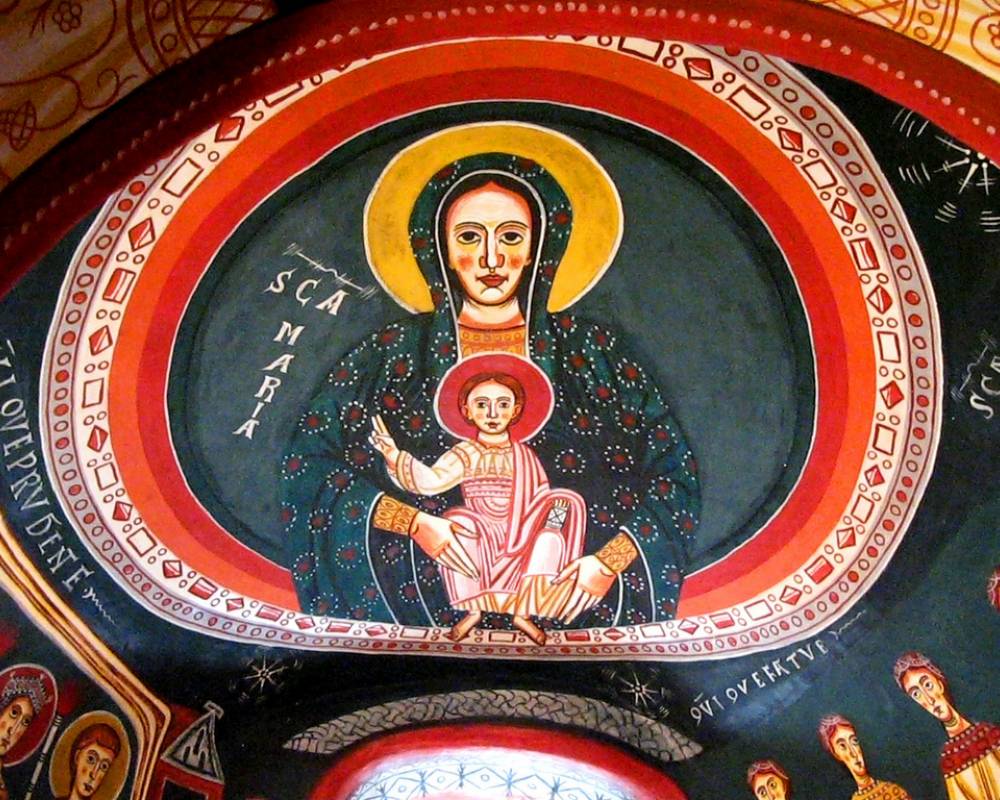
Painting is one of the most unique expressions of Catalan romanesque and, taken as a whole, is the most important in the world. In its origins, it formed a part of the decoration of walls, apses, portals and other architectural features. Later on, it was also used as an ornamentation for liturgical furnishings, such as altar frontals and canopies.
A context which today, for the most part, has been lost. Due to the artistic plundering the country has suffered, the surviving romanesque paintings are being exhibited far away from their places of origin. This is why Sant Vicenç d’Estamariu is such a valuable exception.
Beyond the symbolism and technique, romanesque paintings decorated medieval Christian temples in order to spread the message of the Church to the parishioners. The figurative element is the synthesis of Christian doctrine and the way the Church conceives the order of the world.
Discover the technique, the tems and the abstraction of the romanesque fresco.
Wall paintings of Sant Quirze de Pedret. Carles Illa/ CC BY – NC 2.0
What was life like in Estamariu during the Middle Ages? How was day-to-day life for medieval men and women? Enter the world of the 11th and 20th centuries.
Tapestry of creation. CRBMC/ Department of Culture. CC BY – NC 2.0
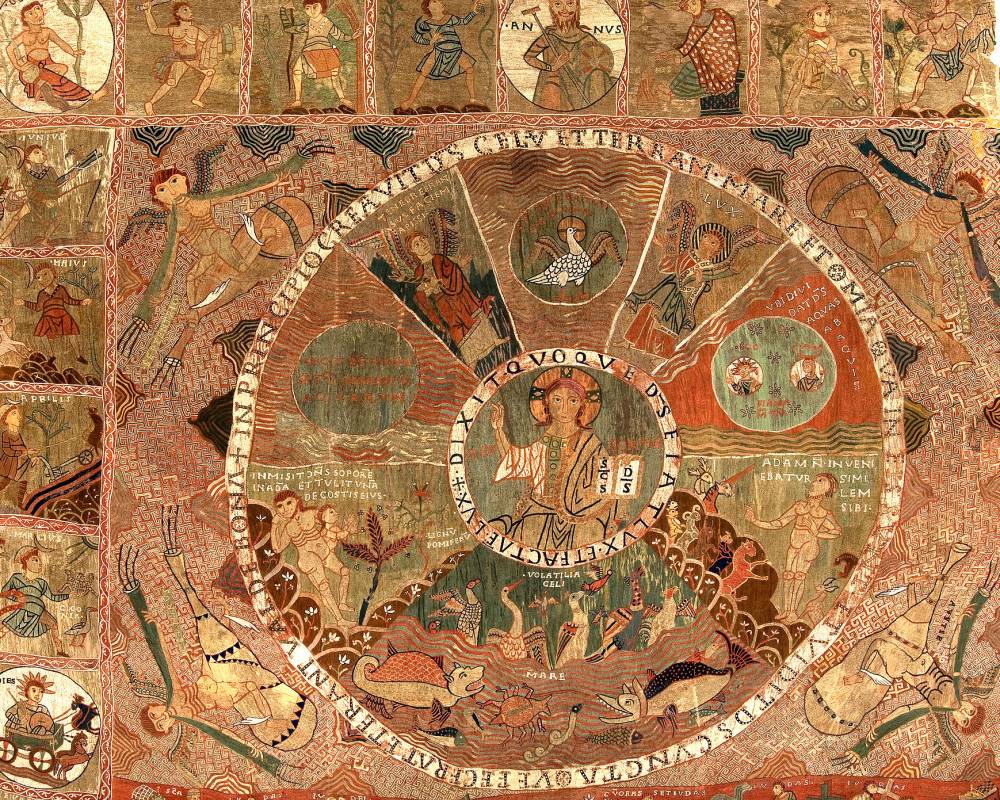
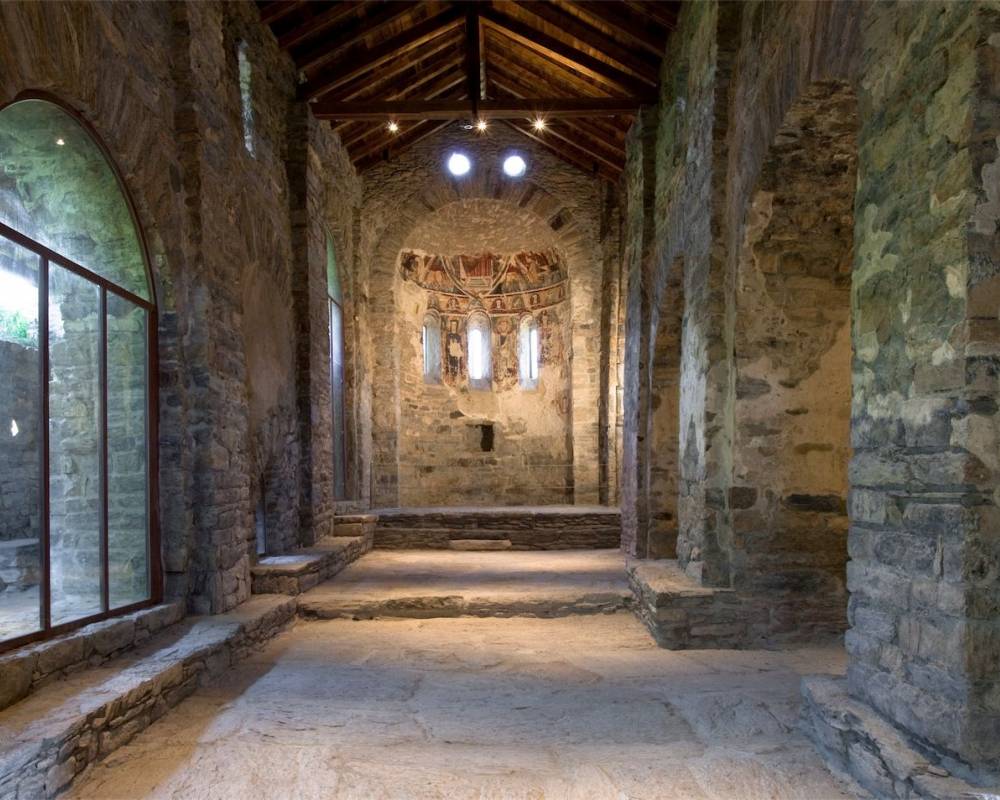
Pere Rovira is a custodian/ restorer at the Centre de Restauració de Béns Mobles de Catalunya (CRBMC) and has worked on the Estamariu project.
What does it mean for a restorer to work on paintings like the ones at Sant Vicenç d’Estamariu?
Given their quality and delicate nature, and the fact that they were discovered by human eyes after so many centuries, it's the very highest a custodian/ restorer could aspire to. It's like playing in the Champions League final.
What was the biggest challenge you faced when working at Estamariu?
The usual challenge with heritage, which is financial. We had to wait many years from the time we discovered the paintings until we had the necessary funds.
Is it possible there might be another finding somewhere else in Catalonia similar to the one in Estamariu?
Over the last thirty years in Catalonia, there have been 3 important discoveries of new Romanesque paintings: Sant Tomàs de Fluvià, Dòrria and Estamariu. There are still a lot of medieval churches which are no doubt hiding some unknown wall painting we haven't identified. We just have to wait and see.
Inner view of the restored nave from the as seen from the foot of the church. Josep Giribet/ Department of Culture. CC BY – NC 2.0